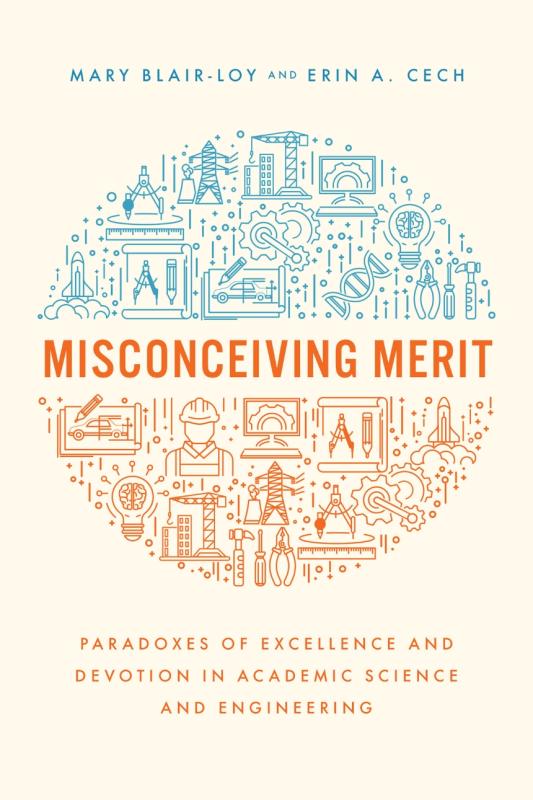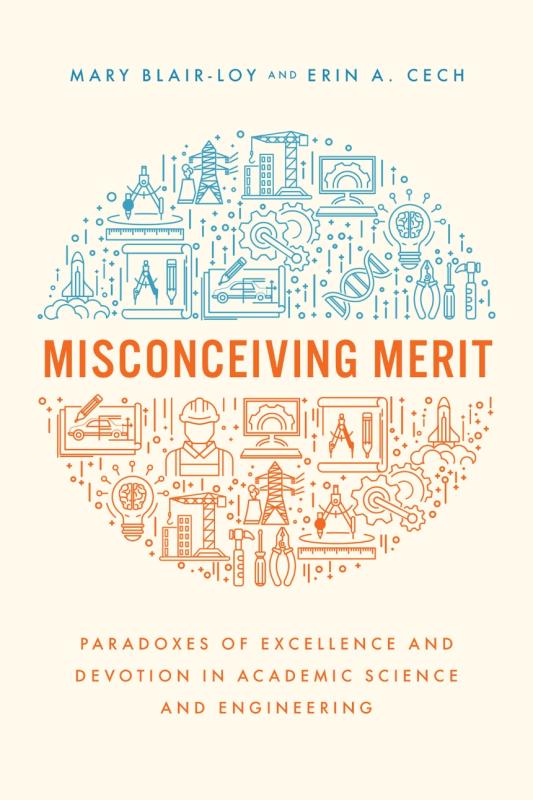
Science is a meritocracy. The merit of scientists’ ideas matters much more than whether a scientist is Black or white, a man or a woman, and is gay or straight. Right?
Not so fast, says a new book, Misconceiving Merit: Paradoxes of Excellence and Devotion in Academic Science and Engineering (University of Chicago Press). The book is by two scholars of work and gender. Mary Blair-Loy is professor of sociology at the University of California, San Diego. She is the author of Competing Devotions: Career and Family Among Women Executives. Erin A. Cech is associate professor of sociology at the University of Michigan. She is the author of The Trouble With Passion: How Searching for Fulfillment at Work Fosters Inequality.
Blair-Loy and Cech studied more than 500 STEM professors at a top research university to reveal how unequal and unfair outcomes can emerge alongside commitments to objectivity and excellence. The authors find that STEM in academe harbors dominant cultural beliefs that not only perpetuate the mistreatment of scientists from underrepresented groups but hinder innovation.
Most Popular
They responded to questions via email.
Q: How did you identify the university you studied? Can you offer any clues about it?
A: Our goal was to study a public research-intensive (R-1) university with strong STEM programs, a university commitment to equity and fairness, and, as much as possible, transparent academic personnel systems. Our case university fulfills these criteria. There, the academic advancement process goes through different levels of review with checks and balances, and decisions at each step and their rationale are made available to the professor under review. The salary and advancement level of all faculty at this university are made public. If fair practices exist anywhere in academic STEM, they should be in place here. Nonetheless, we document how many underrepresented faculty continue to experience devaluation, despite similar productivity metrics across demographic groups.
This case university also has a roughly similar size and student-faculty ratio as other comparably ranked universities in the U.S. Eighty-one percent of our survey sample received their Ph.D.s from a university currently ranked in the top 50 nationally or globally. Our supplemental analysis of data from the STEM Inclusion Study, which includes data on over 7,000 STEM academics from four-year institutions around the country, finds that the cultural beliefs we identify are similarly salient among STEM academics across the U.S. These similarities suggest that the processes and beliefs we identify are present more broadly in academic STEM.
Q: What’s wrong with the belief that science is a meritocracy?
A: The belief in objective, meritocratic evaluation is sacred in academic science and broadly shared across demographics and disciplines. Most believe they know excellence when they see it and that scientists and administrators can identify those making the greatest scientific contributions and reward them fairly. Yet there are several problems with this belief. We’ll briefly mention four.
Related Stories
First, in many instances, this belief is not supported by evidence. Our case study combines four powerful, layered sources of data: administrative data on all tenured or tenure-track STEM faculty members at the case university; a detailed survey on over half of these faculty; in-depth interviews with 85 of them; and a database with external, standardized metrics of publications and grants—outputs that STEM faculty and administrators regard as indicators of productivity and visibility.
Our quantitative analyses show that net of department and advancement level, there are no average differences in the productivity metrics or in time spent on research by gender, race/ethnicity or parenthood. Yet faculty who seem to conform to cultural schemas of excellence and devotion are more likely to be seen as excellent, net of their productivity.
Second, we find that meritocracy therefore often functions as an ideology that justifies the greater respect and resources disproportionately given to some faculty (including white and Asian men and/or assertive faculty) compared to others, who are often viewed as less excellent (disproportionately Black and Latinx men, women of all racial/ethnic backgrounds, mothers, and/or LGBTQ faculty), even though they are just as productive.
We have unusually deep and broad evidence from our case study university. Our results are consistent with many studies on academic STEM populations and help explain the durable underrepresentation of many groups.
Third, this faith in meritocracy distorts the objective and analytical thinking that scientists pride themselves on. In interviews, we witnessed smart, well-meaning faculty tie themselves in knots trying to explain away robust evidence of bias and discrimination in STEM to maintain their belief that STEM is a meritocracy.
Fourth, this broadly shared belief that STEM already functions as a meritocracy can be bad for science.
Q: Your book talks about two dominant beliefs in science: the work devotion schema and the schema of scientific excellence. How are those schemas used to deny opportunities to woman or men who are members of minority groups?
A: The work devotion schema frames science as demanding and deserving single-minded allegiance and frames mothers as lacking the necessary devotion. Yet we find mothers have the same publishing and grant metrics on average as men and as women without children. Mothers in the same departments and advancement levels are devalued and are paid less, net of their productivity. In response to this stigma, mothers often downplay their status as mothers or pass as nonmothers so that they will be taken seriously as academic scientists and engineers.
The schema of scientific excellence is the set of characteristics that forms a yardstick of sorts, which scientists use to measure up one another’s competence and excellence. The schema of scientific excellence valorizes scientists who are viewed by others as brilliant, assertive and self-promoting. White and Asian heterosexual men are often automatically viewed as having these qualities, while underrepresented and minoritized faculty do not benefit from this automatic assumption of excellence, despite their similar average productivity. Academic scientists and engineers who regard themselves as more assertive and self-promoting earn more than others, on average, although they don’t actually produce more scientific work. Black and Latinx men and women, white women, and LGBTQ faculty fare worse than white and Asian heterosexual men, on average, in terms of respect and professional integration, even net of productivity, job level and department.
Women faculty, especially Black and Latinx women, also face respect penalties. Men get credit for relational skills, but women don’t. Assertive “cowboys” are seen as producing the best science, but only majority-race men get full credit for this assertiveness. Black and Latinx women are devalued for assertive characteristics, while Asian women are marginalized for not being assertive enough. And, despite the myth of their independence, majority-race men actually receive more informal mentoring than other junior scientists.
Scientists who care about and are engaged in diversity and inclusion efforts also face respect penalties. They are sometimes seen as too politically engaged and as producing distorted science. Additionally, LGBTQ faculty often feel pressure to downplay their sexual identity and family lives because their identity could be viewed as politicizing and distorting “objective” science.
The schemas of work devotion and scientific excellence are bad for scientists and bad for science. They denigrate caregiving, other creative pursuits, rest and regeneration. They valorize individualistic, self-promoting “cowboys” and “rock stars,” but innovation often requires deeply collaborative work across departments, disciplines, generations and diverse identities.
Q: Is there bias against Asians in science?
A: Compared to the U.S. population, Asian men are not underrepresented in STEM. In our quantitative measures, Asian and white men similarly receive privileges of assumed competence, including greater respect. However, other research on the U.S. professional workforce more generally finds that Asian men are more likely than white men to experience marginalization and barriers to leadership.
Asian women are underrepresented in STEM, compared to their proportion in the national population, and we find that they are often devalued. Previous research shows that Asian women face even more pressure than white women to conform to norms of passive femininity and are more likely to say that they have to put their heads down and work hard while letting others take the lead. In our study, Asian women faculty do not generally have the same privilege as Asian and white men. We find that Black and Latinx women face backlash for assertive characteristics, while Asian women experience marginalization for not being assertive enough.
Q: What can departments, colleges and universities do about the problems you identify?
A: Solutions should first address the structural manifestations of these cultural beliefs. Formal academic review should systematically track and fully reward teaching, inclusive mentoring and translational work as highly as it valorizes article production. Further, academic culture tends to marginalize scientists who may offer something different than mainstream views and experiences. Yet studies show that marginalized scientists are among those most likely to add value to the scientific enterprise. Therefore, academic units should prioritize and reward fair and equitable collaborations among groups of people with diverse perspectives, backgrounds and experience, which research shows are likely to develop the most pioneering work. Departments and universities should fully value professors’ commitments to equitable, diverse and inclusive collaboration.
We identify three opportunities that are especially timely.
First, we find that professors are often more personally committed to collegiality, mentorship and diversity than what they see in their disciplines. The daylight between scientists’ own values and what they see as valorized in STEM creates an opportunity to reconsider what counts as excellence in the profession.
Second, the post-pandemic period is a critical time to reckon with the work devotion schema’s contributions to devaluing the excellence of mothers in STEM.
Third, Western approaches to science can learn much from feminist, postcolonial and Indigenous approaches that offer insight into how to value perspective-taking, collaboration, credit-sharing and humility in the process of knowledge creation.
STEM work has always been inherently cultural and social. It’s high time to embrace diversity and equity as an amplifier of innovation and not a threat to it.








